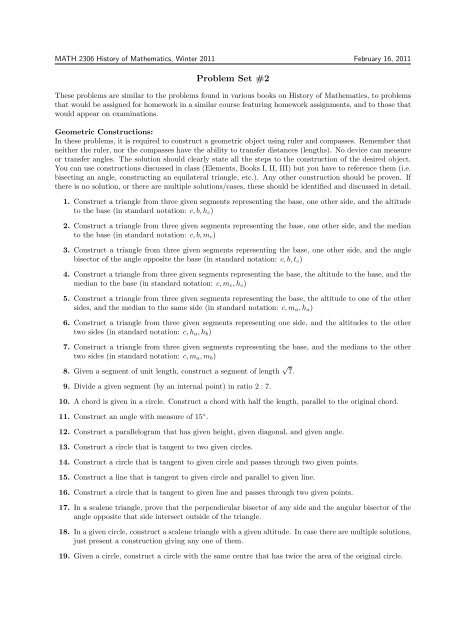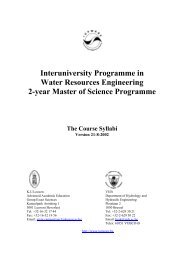Problem Set #2 - Homepage Usask
Problem Set #2 - Homepage Usask
Problem Set #2 - Homepage Usask
You also want an ePaper? Increase the reach of your titles
YUMPU automatically turns print PDFs into web optimized ePapers that Google loves.
MATH 2306 History of Mathematics, Winter 2011 February 16, 2011<br />
<strong>Problem</strong> <strong>Set</strong> <strong>#2</strong><br />
These problems are similar to the problems found in various books on History of Mathematics, to problems<br />
that would be assigned for homework in a similar course featuring homework assignments, and to those that<br />
would appear on examinations.<br />
Geometric Constructions:<br />
In these problems, it is required to construct a geometric object using ruler and compasses. Remember that<br />
neither the ruler, nor the compasses have the ability to transfer distances (lengths). No device can measure<br />
or transfer angles. The solution should clearly state all the steps to the construction of the desired object.<br />
You can use constructions discussed in class (Elements, Books I, II, III) but you have to reference them (i.e.<br />
bisecting an angle, constructing an equilateral triangle, etc.). Any other construction should be proven. If<br />
there is no solution, or there are multiple solutions/cases, these should be identified and discussed in detail.<br />
1. Construct a triangle from three given segments representing the base, one other side, and the altitude<br />
to the base (in standard notation: c, b, hc)<br />
2. Construct a triangle from three given segments representing the base, one other side, and the median<br />
to the base (in standard notation: c, b, mc)<br />
3. Construct a triangle from three given segments representing the base, one other side, and the angle<br />
bisector of the angle opposite the base (in standard notation: c, b, tc)<br />
4. Construct a triangle from three given segments representing the base, the altitude to the base, and the<br />
median to the base (in standard notation: c, mc, hc)<br />
5. Construct a triangle from three given segments representing the base, the altitude to one of the other<br />
sides, and the median to the same side (in standard notation: c, ma, ha)<br />
6. Construct a triangle from three given segments representing one side, and the altitudes to the other<br />
two sides (in standard notation: c, ha, hb)<br />
7. Construct a triangle from three given segments representing the base, and the medians to the other<br />
two sides (in standard notation: c, ma, mb)<br />
8. Given a segment of unit length, construct a segment of length √ 7.<br />
9. Divide a given segment (by an internal point) in ratio 2 : 7.<br />
10. A chord is given in a circle. Construct a chord with half the length, parallel to the original chord.<br />
11. Construct an angle with measure of 15 ◦ .<br />
12. Construct a parallelogram that has given height, given diagonal, and given angle.<br />
13. Construct a circle that is tangent to two given circles.<br />
14. Construct a circle that is tangent to given circle and passes through two given points.<br />
15. Construct a line that is tangent to given circle and parallel to given line.<br />
16. Construct a circle that is tangent to given line and passes through two given points.<br />
17. In a scalene triangle, prove that the perpendicular bisector of any side and the angular bisector of the<br />
angle opposite that side intersect outside of the triangle.<br />
18. In a given circle, construct a scalene triangle with a given altitude. In case there are multiple solutions,<br />
just present a construction giving any one of them.<br />
19. Given a circle, construct a circle with the same centre that has twice the area of the original circle.
MATH 2306 History of Mathematics, Winter 2011 February 16, 2011<br />
20. Given a triangle, inscribe a square in it so that one of the sides of the square is on the base, and the<br />
other two vertices are on the other two sides.<br />
Other Geometric <strong>Problem</strong>s:<br />
21. Let p and q be two different prime numbers. Suppose you know how to construct regular p-gon and<br />
regular q-gon. Explain how to construct regular pq-gon.<br />
22. Prove that if a quadrilateral has a circle inscribed in it, then the sum of the lengths of one pair of<br />
opposite sides equals the sum of the lengths of the other pair of opposite sides.<br />
23. Suppose you have a 19 ◦ -wedge. That is, you have a geometric tool that can construct 19 ◦ angles<br />
only. In addition to that you have a pencil, i.e. you can mark any point along the sides of the wedge,<br />
including the vertex of the angle. No other instruments are available. Construct 1 ◦ angle.<br />
24. Using the wedge tool introduced above, can you construct 1 ◦ if the angle of the wedge is 17 ◦ ? What<br />
if it is 18 ◦ ?<br />
25. In ∆ABC a circle is outscribed, so that it touches the side AB and the extensions of the sides AC and<br />
BC. Prove that the tangents to this circle from point C equal half the perimeter of ∆ABC.<br />
26. In a convex quadrilateral, is the sum of the two diagonals smaller than, equal to, or greater than the<br />
perimeter of the quadrilateral?<br />
27. Same question as above, with respect to the half-perimeter.<br />
28. Prove that in a non-isosceles triangle, the angle bisector of the angle opposite the base lies between<br />
the median and the altitude to the base.
















